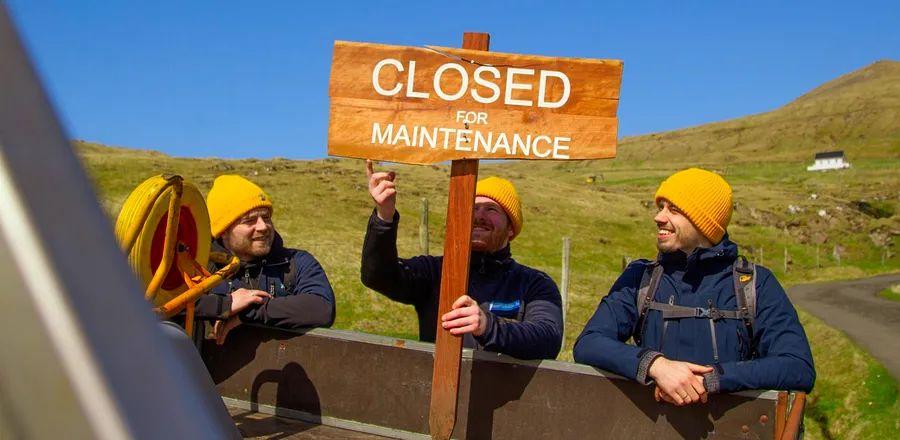Transforming a Voluntourism Initiative into an Ideal Getaway in the Faroe Islands

The lush hills of Suðuroy plunge dramatically into the vast North Atlantic below. On this bright May afternoon in the Faroe Islands, the sun gleams as brightly as the yellow beanies worn by my Swedish friend Patricia and me, as we paint the sign for Ryskivatn, a nearby lake, in vibrant crimson. While we chat and enhance the weathered sign for better visibility during foggy spells, three curious locals approach to observe our efforts—some of the 70,000 sheep that inhabit the Faroe Islands.
The Faroe Islands are renowned for having more sheep than residents. Yet in 2023, about 130,000 international tourists visited this remote Nordic archipelago of 18 volcanic islands, situated midway between Iceland and Scotland, far surpassing the approximate 54,000 full-time Faroese inhabitants. Hence, it’s no wonder that the self-governing region of Denmark is increasingly concerned about its rising tourist numbers rather than its sheep.
Following in the footsteps of Venice and Amsterdam, the Faroe Islands will introduce tourist taxes in October 2025, aimed at funding a Nature Preservation Fund to maintain hiking paths and support other local tourism initiatives and nature conservation efforts.
However, unlike many other tourist spots, the Faroese government has opted for a more innovative strategy to combat overtourism by engaging visitors in the stewardship of the islands’ delicate ecosystems and the development of sustainable infrastructure. Each spring, the Closed for Maintenance, Open for Voluntourism program temporarily closes some of the country’s most frequented sites for a few days. In exchange for complimentary accommodation and meals, a select group of international volunteers is invited to take part in various infrastructure projects, such as building pathways to protect the islands’ natural charm and installing directional signs on trails and roads for the safety of both visitors and locals.
Since the launch of the Closed for Maintenance, Open for Voluntourism initiative in 2019, 409 volunteers from 40 different countries have completed about 50 projects across 10 islands. With over 23,800 applicants in the past five years, the program boasts an acceptance rate of roughly 1.7 percent—making it more competitive than Harvard for prospective volunteers.
This past May, I was fortunate enough to be among those selected. During my four days with fellow volunteers on Suðuroy, I realized that this initiative is not just a marketing ploy; it serves as a meaningful way to educate travelers about their impact on such a remote and stunning location. Additionally, I made lasting friendships with like-minded individuals from around the globe.
Here’s a glimpse into the experience of participating in the Closed for Maintenance, Open for Voluntourism initiative.

Photo by Emily Madinsky
The Selection Procedure
This past January, 5,945 eager volunteers from 96 different countries applied for 80 openings in the 2024 initiative on the Visit Faroe Islands website. Approximately 70 percent of the selected volunteers were chosen at random, while the remaining spots were filled based on relevant experience that aligned with specific projects. (Generally, volunteers need to be at least 18 years old and possess no special skills beyond the ability to navigate uneven terrain and use basic tools like hammers, wheelbarrows, and shovels during the work.)
After the fortunate 80 were chosen and notified, we had 48 hours to arrange our flights to the Faroe Islands. (Room and board for the four-night stay are covered, but volunteers are responsible for their own airfare. Currently, Atlantic Airways offers flights primarily through Copenhagen, along with some seasonal routes and a new seasonal flight from New York. SAS provides flights from Copenhagen, and Icelandair flies in from Reykjavík.)
Alongside the international volunteers, 30 local participants joined eight different group projects across the islands, resulting in roughly a 50/50 mix of foreigners and locals on most maintenance teams. In my group, I was accompanied by three other solo female travelers from Canada, Sweden, and Denmark, as well as a couple from Poland. While most applicants are European, some groups included volunteers from as distant as South Africa and Bolivia.
Although there are no official guidelines for selection, it appears that persistence or a prior visit to the Faroe Islands may enhance your chances. Some in my group applied multiple times before finally gaining acceptance on their third attempt, while others were selected on their first try after passionately describing their love for the country in the application’s short essay section.
Alongside the six of us from abroad, our group included five Faroese men from the capital, Tórshavn, who participate in this initiative annually as a group of friends. The group was led by Majken Sandá from the local Suðuroy tourism board. We were also accompanied by two local landscapers who provided all the necessary tools and guided us in our hiking trail maintenance project on Suðuroy.

Photo by Lyndsey Matthews
The Projects
This year’s Closed for Maintenance initiative kicked off on Wednesday, May 1. After a brief orientation lunch in the town of Bøur, near the country’s only airport, volunteers were divided into eight groups, each identified by the color of the wool beanies provided at arrival. While the team with the petrol blue beanies headed to the village of Tjørnuvík to improve access to its renowned black sand beach, and the army green beanie group began constructing a sheep fence near the capital to safeguard a wetland, the yellow beanie crew and I boarded a two-hour ferry to Suðuroy for a trail maintenance project. As the southernmost island in the Faroes, Suðuroy sees fewer visitors than the areas closer to the capital, but the local tourism board is keen to ensure its infrastructure is ready for the anticipated increase in visitors.
Once we arrived in the town of Vágur, nestled in a bay on the island's eastern side, we began our work on Thursday, May 2, focused on repairing and enhancing the signage along the hiking trail that ascends Gjógvaráfjall, an 1,100-foot mountain towering over the town. The existing path was often mistaken for private farmland due to insufficient signage, so much of our effort went into installing blue trail markers and replacing decayed posts along the route.
At the trailhead in town, my new Canadian friend Emily and I were tasked with cleaning the staircase that marks the start of the hike. While we scraped, scrubbed, and power-washed the concrete steps to remove moss and grass, several neighbors emerged from nearby homes to chat with us, while one of their puppies tried to divert our attention by playing ball. (She succeeded, at least for a few moments.)

Photo by Emily Madinsky
On the second full workday, Friday, May 3, we focused on adding more blue trail markers at the top of the path and creating a seating area to take in the view. Although it can be windy up there, the vista is well worth the trek, offering sights of the entire town, the fjord carving the bay, and the ocean beyond. Now that the trail is clearly marked, it should take about an hour to walk from town to the summit along the 1.5-mile path at a steady Faroese pace.
Throughout the two full workdays, in addition to clearing and marking the trail to Gjógvaráfjall, our team repainted road signs directing visitors to Ryskivatn lake and other sites beyond Vágur, cleaned debris from the town’s beach, and constructed a footbridge over a severely eroded section of a path on the opposite side of the mountain.
Accommodation and meals
In return for our efforts on various maintenance tasks, we volunteers were provided with complimentary local lodging and meals from Wednesday afternoon until breakfast on Sunday—though those hoping to volunteer shouldn’t expect to stay in upscale hotels or dine at trendy restaurants like Ræst in the capital. For instance, my group stayed in a basic scout’s hut in Vágur, featuring twin beds and two shared bathrooms for our dozen members, but it was clean and charming. The scout’s hand-painted banners depicting puffins and gulls adorned the bedrooms and the common area downstairs, lending a quirky, Wes Anderson-like charm to our adult sleepaway camp experience.

Photos by Lyndsey Matthews
Our meals featured straightforward dishes like fish soup, hearty burgers, and classic meat and potatoes from local restaurants. On our last night in Vágur, Nina, the local landscaper who guided our project, prepared a grand feast for us at the local dance hall, serving prime rib, shrimp mousse, and halibut with mango curry sauce. (She humorously referred to the meal as “Faroese with a major kick in the French direction.”) After dinner, a local dance troupe taught us the Faroese chain dance—a simple rhythm of two steps left and one step right while holding hands, led by a singer reciting traditional verses. We exchanged stories, took shots of aquavit, and shared language lessons late into the night. (I now know how to say “fart” in Faroese, Swedish, Polish, and Danish. Meanwhile, other groups engaged in deep discussions about EU economic policies at their tables.)
The final evening
With our volunteer duties completed on Friday, we packed our bags on Saturday and left the scout’s hut to explore more of Suðuroy before taking a helicopter back to Tórshavn. The 20-minute flight with Atlantic Airways provided stunning views of the islands and was much quicker than the two-hour ferry. Upon our stylish return to the capital, we checked into the Hilton Garden Inn (courtesy of the program) and then headed to Oy Brewery down the street for our farewell dinner. There, we reunited with the other seven volunteer groups and each team presented a short talk—complete with PowerPoints—about their projects. After the presentations, we enjoyed a family-style barbecue while local bands, including Páll Finnur Páll, performed and a DJ played music until 1 a.m. The festivities didn’t end there; when I woke up for my flight the next morning, I heard tales of others partying in town until 5 a.m.

Photo by Emily Madinsky
Takeaways
As I watched the striking cliffs of the Faroe Islands fade away during my flight on Sunday, my only regrets were that the program wasn’t longer and that most of us may not get the chance to participate again. With just two days of volunteer work and four days together as a group, it felt like we were only beginning to bond as a team when the trip concluded. Nonetheless, it was an invaluable experience that I wholeheartedly recommend to travelers who enjoy getting their hands dirty alongside others with a similar mindset. Being aware of how overtourism impacts a rising destination is one thing; actively engaging in its prevention is quite another.
Even if you don’t get accepted into this highly selective program, you should definitely explore this rugged North Atlantic archipelago—and appreciate the hard work we contributed to hiking trails in other areas like Nólsoy, Sandoy, and beyond. Alternatively, you can take in the breathtaking scenery at maintenance projects completed in past years at locations like Slættaratindur, the tallest mountain in the Faroe Islands, the “hanging lake” at Trælanípa, and the island of Mykines, known for its puffin colonies.
To learn when registration opens for the 2025 “Closed for Maintenance, Open for Voluntourism” program, sign up for the Visit Faroe Islands newsletter.

1

2

3

4

5
Evaluation :
5/5